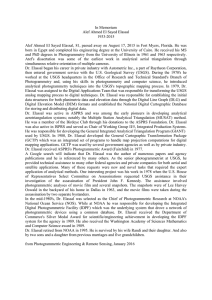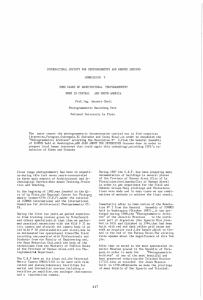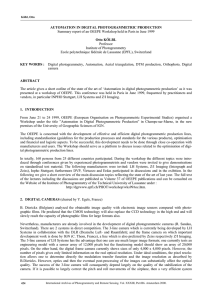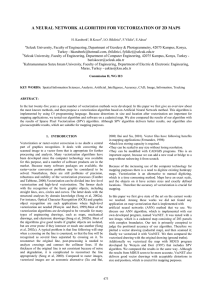BRAZILIAN QUALITY CONTROL SYSTEMS FOR DIGITAL PHOTOGRAMMETRY MAPPING PRODUCTION
advertisement
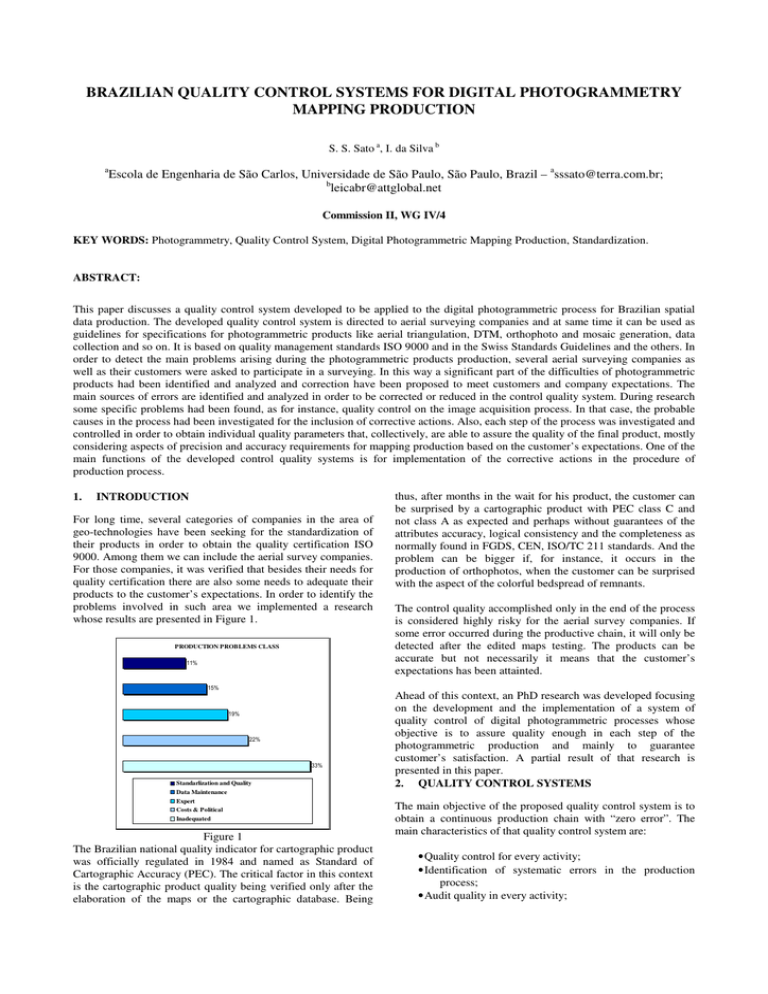
BRAZILIAN QUALITY CONTROL SYSTEMS FOR DIGITAL PHOTOGRAMMETRY MAPPING PRODUCTION S. S. Sato a, I. da Silva b a Escola de Engenharia de São Carlos, Universidade de São Paulo, São Paulo, Brazil – asssato@terra.com.br; b leicabr@attglobal.net Commission II, WG IV/4 KEY WORDS: Photogrammetry, Quality Control System, Digital Photogrammetric Mapping Production, Standardization. ABSTRACT: This paper discusses a quality control system developed to be applied to the digital photogrammetric process for Brazilian spatial data production. The developed quality control system is directed to aerial surveying companies and at same time it can be used as guidelines for specifications for photogrammetric products like aerial triangulation, DTM, orthophoto and mosaic generation, data collection and so on. It is based on quality management standards ISO 9000 and in the Swiss Standards Guidelines and the others. In order to detect the main problems arising during the photogrammetric products production, several aerial surveying companies as well as their customers were asked to participate in a surveying. In this way a significant part of the difficulties of photogrammetric products had been identified and analyzed and correction have been proposed to meet customers and company expectations. The main sources of errors are identified and analyzed in order to be corrected or reduced in the control quality system. During research some specific problems had been found, as for instance, quality control on the image acquisition process. In that case, the probable causes in the process had been investigated for the inclusion of corrective actions. Also, each step of the process was investigated and controlled in order to obtain individual quality parameters that, collectively, are able to assure the quality of the final product, mostly considering aspects of precision and accuracy requirements for mapping production based on the customer’s expectations. One of the main functions of the developed control quality systems is for implementation of the corrective actions in the procedure of production process. 1. INTRODUCTION For long time, several categories of companies in the area of geo-technologies have been seeking for the standardization of their products in order to obtain the quality certification ISO 9000. Among them we can include the aerial survey companies. For those companies, it was verified that besides their needs for quality certification there are also some needs to adequate their products to the customer’s expectations. In order to identify the problems involved in such area we implemented a research whose results are presented in Figure 1. PRODUCTION PROBLEMS CLASS Standarlization and Quality Garantee Data Maintenance Expert Personal Costs & Political Support Inadequated Data/Production Figure 1 The Brazilian national quality indicator for cartographic product was officially regulated in 1984 and named as Standard of Cartographic Accuracy (PEC). The critical factor in this context is the cartographic product quality being verified only after the elaboration of the maps or the cartographic database. Being thus, after months in the wait for his product, the customer can be surprised by a cartographic product with PEC class C and not class A as expected and perhaps without guarantees of the attributes accuracy, logical consistency and the completeness as normally found in FGDS, CEN, ISO/TC 211 standards. And the problem can be bigger if, for instance, it occurs in the production of orthophotos, when the customer can be surprised with the aspect of the colorful bedspread of remnants. The control quality accomplished only in the end of the process is considered highly risky for the aerial survey companies. If some error occurred during the productive chain, it will only be detected after the edited maps testing. The products can be accurate but not necessarily it means that the customer’s expectations has been attainted. Ahead of this context, an PhD research was developed focusing on the development and the implementation of a system of quality control of digital photogrammetric processes whose objective is to assure quality enough in each step of the photogrammetric production and mainly to guarantee customer’s satisfaction. A partial result of that research is presented in this paper. 2. QUALITY CONTROL SYSTEMS The main objective of the proposed quality control system is to obtain a continuous production chain with “zero error”. The main characteristics of that quality control system are: • Quality control for every activity; • Identification of systematic errors in the production process; • Audit quality in every activity; The International Archives of the Photogrammetry, Remote Sensing and Spatial Information Sciences, Vol. 34, Part XXX • Fault and process registering, when detected – documentation; • Implementation of corrective actions when detected in the production chain. The Quality Control Systems workflow for Digital Photogrammetric Processing (PQCS) is presented in Figure 2. Two steps compose PQCS: (i) procedure description and (ii) quality analysis. Quality Control Procedures - Part I Concept Model Procedures Description Work Flow Graphical Model Regulamentations Specifications Working Instructions Perform Process Corrective Actions Quality Analysis - Part II Quality Control Line Prodruction Image Aquisition Quality P arameters Scanning QC P roject P reparation Ground Control Input Quality P arameters Tonal P ixel Sizel Ca mera Brighteness Contrast Scanner Calibration Images files Ca mera Data Interior Orientation QC Image Sequencies Flight Data DTM Generation Aerial Triangulation QC Vectorization Restituição Ortophoto Generation P roduct Quality Figure 2 Functionality workflow of the PQCS 2.1.1 Procedure Description This part of the system includes all documents that must be issued in order to guarantee a high level of quality. The following are the principal parameters to be considered in that control phase: − Specifications: The existing technical specifications shall be translated to the operational level under the form of spreadsheets graphically indexed and workflow diagrams contemplating graphical illustrations of the instructions. − Regulations: All norms, regulations or requirements of the specifications inherent to the execution of the mapping project are placed in first plan during activities planning and quality control measurement specifications. − Work Instructions: Every activity must be executed in function of specification’s requirement. The registered instructions will allow implementing the company know-how, making it less susceptible to unexpected problems that can occur during production process. It makes possible also, to define a work severity that will guarantee the quality control to the customer. − Corrective Actions: Quality control means error reduction or elimination. The corrective actions documentation serves as a registering of efforts carried out in order to obtain the desired quality. The main objective is to eliminate or to prevent the causes of nonconformity or imperfections in the spatial data production processes. These actions are registered with the purpose of keeping a description of the quality. − Applied Processes: As they are applied, they are registered in form of reports and printed in the graphical project and also as table for activities control. − Conceptual Model: The adoption of a data conceptual model during the negotiation phase must lead to a "prototype” of the product in order to facilitate the definition of the product and to adequate it for use or to make it adjusted to the customer’s necessities. 2.1.2 Quality Analysis The second PQCS step is based on some Suisse photogrammetric directives (draft version). It deals with aero phtogrammetric process including image shooting, processing and scanning; terrestrial control points, aerotriangulation, DTM generation, ortophotos generation and vectorization. The main quality items observed in the system are presented in annexed Table 1. 2.1.2.1 Quality Control and Vectorization For horizontal and vertical positioning quality control during vectorization the Eslami Rad (1995) recommendation is used, as described in Equations 1 and 2 on Table 1. The sigma values are the same as presented in that table. 2.2 Attributes Accuracy and Completeness The implementation of a logical model including topological restriction definition in the created classes and the implementation of visualization methods must avoid logical consistency errors in the database. For instance, permissible values are established to avoid the occurrence of “overshoots” e “undershoots” phenomena. The first one can be explained, as for instance, as a line that can surpass an intersection during a vectorization process. The second one can be explained, as for instance, as a procedure to avoid arcs, lines and polygons being too far way from neighbor elements. Other established rules are configured in the digital photogrammetric system in such a way to alert the operator if any restricted action is taken. The proposed basic rules consider the following factors: • Parallelism between lines (road edges, canals,...); • Lines perpendicularity (building edges...); • Non duplicated lines or polygons; • Input acceptance for layers, color, etc; • Minimal proximity for lines; • Minimal polygon dimension; • Minimal squaring; • Automatic polygons closing. An example on how to proceed for data collection automation restriction was implemented on a data object oriented system from Laser Scan Company – Lamps2. The following aspects were considered in the implemented testing: The International Archives of the Photogrammetry, Remote Sensing and Spatial Information Sciences, Vol. 34, Part XXX • Linear elements and areas for some classes should not be interrupted; • It is not allowed any element duplication; • Hierarchical classes must organize coincident elements; • Element connectivity forbidden or allowed; • Every solid object must have closed polygons, even when interrupted by other element; • Automatic simbology for some classes with proximity restriction. 2.2.1.1 Corrective Action During Vectorization Process 2.2.1.2 Conformity Testing 2.2.1.3 Documentation 3.1 Scanning In order to obtain images with high quality, a pair of diapositives images were scanned using a DSW200 Scanner from Leica Geosystems. After scanning every image was submitted to a visual quality control in a computer monitor. Also, some image regions were analyzed particularly in zoom mode for tonality quality control. In that case, it was verified for example the occurrence of some dust dots in the image, as presented in Figure 3. During vectorization, all corrective actions are related to the operator and to the action that must be reconsidered. A preinterpretation can be considered as a corrective action for the vectorization process. This can be seen, for example, in the case of an ortophoto generation using automatic DTM and control points generated from a map to provide a document for terrain evaluation and object identification in the field. As a result, the field surveyors will provide a digital document already codified in agreement with the vectorization specification. Such a procedure can eliminate the so called terrain interpretation procedure and may reduce misinterpretation during vectorization what will lead to a gain of productivity. To finalize, the PQCS shall test some representative sampling of the product in order to verify if they are in agreement with the pre-established specifications. To validate the final printed product we recommend the use of a quality procedure based on the Quality Management from Ordinance Survey-UK. Considering that Digital Photogrammetric Systems can store results as ASCII files, the PQCS documentation generation is facilitated. Two types of documents are needed in the vectorization process: • A report attesting the reached quality; • A procedure documentation to clarify the data use and how they have been validated. It is important to consider the issue of an instruction manual or a user manual. Figure 3 The dust dots were caused by dust in the scanner glass support. It was also verified that even after a high control cleaning and with temperature and humidity control, a residual dust might be found making the process vulnerable to even a strict control. In that case, only an adequate documentation and a report of corrective actions can help to obtain high level of quality. If no action had been taken during scanning, the problem would be detected only in the final process, which could be, for instance, during ortophoto generation. In case of high quality requirement, the work could be rejected 3.2 Interior Orientation For interior orientation parameters quality testing, a series of images from different companies were tested. All images were oriented using SOCET SET Digital System from BAE Systems. All measurements are presented in the Table 2. Company At the end of each production process a proper documentation must be issued. That documentation must be revised in order to validate the precision and the accuracy attainted. They shall also be presented in the final report. Some other information, as described below, can be also included in the final report: • Date of the applied quality test; • Corrections and modifications applied after testing • Indications on how the new quality information was verified. 3. VALIDATION OF THE PQCS To evaluate the PQCS functionality and to validate all the quality parameters proposed, a series of practical experiments of quality control was applied in the following photogrammetric procedures: scanning, interior orientation and aerotriangulation. A B B C D E E F Photo Scale 1:35.000 1:30.000 1:30.000 1:35.000 1:8.000 1:8.000 1:8.000 1:8.000 Camera RC10 RC 10 RMK TOP RC10 RC8 RC10 RC10 RMK TOP Quantity of images 2 2 4 2 2 2 2 5 Pixel Size [µm] 21 25 22 21 20 24 24 25 RMS [µm] 19,8 23,9 9,2 19,8 10,3 13,3 18,7 8,9 [Pixel] 0,99 0,96 0,37 0,99 0,52 0,56 0,78 0,41 Table 2 The practical results have shown that it would be difficult to reach an international standard of quality. A EMQ less than 0,5 pixel was obtained only when images are made using new generation cameras (RMK TOP, for instance). It must be stressed that best results were obtained only when one or two measurements higher than 15µm have been eliminated. This is only possible if cameras with 8 fiducial marks are used. As can be seen 33% of measurements were higher than 15µm. Three possible sources of error can be responsible for those results: The International Archives of the Photogrammetry, Remote Sensing and Spatial Information Sciences, Vol. 34, Part XXX (i) Camera quality, since several of them are old generation cameras; (ii) Diapositive copy, and (iii) Scanner calibration. ( 3.3 Digital Aerotriangulation To validate quality PQCS parameters from digital aerotriangulation processing three blocks of images from different projects were used. See Table 3. Blocks A and B are Brazilian projects. Altdorf project is a Suisse project. All projects were processed using the Digital System SOCET SET from BAE System and aerotriangulation software ORIMA, from Leica Geosystems. Projects A B Altdorf N° of Scale images Photos 89 1:30.000 6 1:8.000 8 1:4.700 Image Resolution 25 µm 24 µm 25 µm Ground Controls 42 10 8 Total of points [images] 553 65 125 Table 3 Table 4 presents results obtained from the aerotriangulation adjustment. From aerotriangulation for Block A, due to an image drift effect detected, some tie points were very difficult to be measured. That problem can create a low level of quality during vectorization process. PROJECT A B Altdorf σ0 [µm] 20 9,6 6,2 ( Figure 4 4. CONCLUSIONS The benefit of applying the PQCS model are mainly the guarantee of quality and increasing level of productivity at short term and decreasing costs at medium term. By applying such a quality control procedure any company can assure high level of acceptation of its product and reduce risks of double working. All faults detected during practical tests indicate that no quality control was applied at any step of the production flow, mainly on the beginning of the project. EMQ after adjustment [m] X 1,32 0,40 0,28 Y 1,22 0,34 0,32 Z 0,41 0,26 0,12 Table 4 Quality of block A was not satisfactory since residual values were higher than 40µm and also because of the drift effect. The result obtained for Block B was also below quality expectative since it was detected that some control points had accuracy worst than 5 centimeter and even after a hard work of refining no good adjustment accuracy could be obtained (8,5µm or 0,3 pixel). In such a block it was necessary to use additional parameters such as film stretching and lens deformation correction in order to obtain at least an acceptable result. The reason for that low profile result can be explained by bad image quality, bad film quality or bad negative reproduction. For the Altdofr block all results converged as expected. In that case, productivity and quality results are clearly better than blocks A and B. Existing pre-signalized control points and superior image quality can be the explanation for the best results obtained. Figure 4 shows image difference for Project B and Altdorf. 5. BIBLIOGRAPHY Ackermann, R. J. & Eslami Rad, A., 1996. Quality Control Procedure for Photogrammetric Digital Mapping. In: International Archives of Photogrammetry and Remote Sensing. Vol. XXXI. Part B4. pp. 1032-1040. ASPRS., 1995. Draft Standards for Aerial Photography. In: ASPRS Professional Practice Division Specification and Standards Committee. Baltavias, E. P., 1994. Test and Calibration Procedures for Image Scanners. In International Archives of Photogrammetry and Remote Sensing. 30(1). pp. 163-170. BMGSB, 2002. Base Mapping and Geomatic Services Branch. Specifications for Scanning Aerial Photographic Imagery. British Columbia, Ministry of Sustainable Resource Management. Victoria BC. CERCO, 2000. Handbook for implementing a QMS. In: NMAVI. CERCO Work Group on Quality 18/08/2000. D+M¨& S+T, 1996. Les Nouvelles Directives de la Détermination Photogrammétrique des Points Fixes (Aerotriangulation) In: Directives de Points Fixes. Version Juliet 1996. Eslami Rad, A. (1995). Development of a Quality Control Procedure for Photogrammetric Digital Mapping. Thesis of Master of Science in Integrated Map and Geo-Information Production (IGP). International Institute for Aerospace and Earth Sciences (ITC). Enschede. Netherland. FDGC, 1999. Federal geographic Data Committee. Geospatial Positioning Accuracy Standards. Part 3: National Standard for The International Archives of the Photogrammetry, Remote Sensing and Spatial Information Sciences, Vol. 34, Part XXX Spatial Data Accuracy. <http://fdgc.cr.usgs.gov/fdgc.htm>. (Accessed 16 Jul. 1999). Century. American Society for Photogrammetry and Remote Sensing. pp. 7-14. GROUPE DE TRAVAIL SUR L’ASSURANCE DE LA QUALITE (2000). Guide d’Assurance de la Qualité – Photogrammétrie et Génération de MNT. Vérsion Définitive. Lausanne – Suíça. Kölbl, O., 2000. DTM Specification. Rapport Téchnique. IPHOT, Départrament de Génie Rural. École Polytéchnique Fédérale de Lausanne – EPFL. ISO/TC 211 (2000). ISO 15046: Geographic Information/Geomatics. Parte 14. documento 920. Draft Standards. <http://www.statkart.no/isotc211/>. (accessed 14 May 2000). Jacobsen, K., 2000. Block Adjustment. Special Papers. Institute for Photogrammetry and Surveying Engineering. University of Hannover. Germany. <http://www.ipi.uni-hannover.de/Publications>. (accessed 28 Nov. 2002). Kölbl, O. & Bach, U., 1996. Tone Reproduction of Photographic Scanner. OEEPE Workshop on the application of Digital Photogrammetric Workstations. EPFL, Switzerland: <http://dgrwww.epfl.ch/PHOT/workshop/wks96/art_1_2.html>( acessed 21 Jun 1999). Kölbl, O., 1994. Survey of High-Quality Photographic Scanners. In Mapping and Remote Sensing Tools for the 21st SDTS, 1997 - Spatial Data Transfer Standard. American National Standard for Information Systems - Part 1, Logical Specifications. DRAFT for Review, November 20, 1997. American National Standards Institute, Inc. Sato, S. S., 2003 – Sistema de Controle de Qualidade dos Processos Fotogramétricos Digitais para a Produção de Dados Espaciais. Ph.D. thesis – Escola de Engeharia de São Carlos – Universidade de São Paulo. Sussland, W. A., 1996. Le manager, La Qualité et les Normes ISO. De l’ISO 9000 vers la Qualité Totale. Presses Polytechniques et Universitaires Romandes. Tastan, H & Altan, M.O., 1999. Spatial Data Quality. Proceedings of the Third Turkish-German Joint Geodetic Days. Istanbul, pp.15-30. . Elements Requirements Film Density Photography Materials Film resolution (processed) Camera ≤ 20µm Certificate of Camera Calibration < 2 years. Image Quality Overlap and Side lap Vertical Angle/Drift Scanning - Analysis of the certificate of calibration Focal length lens having a usable angular field not less than 90 degrees - Analysis of the certificate of calibration and not exceed ±3 mm (153 ±3 mm). Using of adequate filters. Images should be with a brightness, - Film exposed with a quality control color target contrast, tonality and illumination - Visual Inspection of images. satisfactory, color without clouds, risks and others. - Using template for measuring the cover area of the OL ≥ 60% images. SL ≥ 30% - Index of photos with a flight line Project - Analyses of the flight planning report and photography flight resulting report. Tilt < 3° Drift < 5° Geometric Resolution ≤ 16 µm (B/W). ≤ 20 µm (Color). Radiometric Resolution Minimal 8 bits for each channel - Density sensitivity scale (21 gray level). - Kodak Q60 EktachromeTemplate Control Points Network adjustment better than 1: 100.000 - Registers sheets of processing data and quality control done. Supplementary Control Points Accuracy better than 10 cm. Use of pre-signalized control points Interior Orientation Average Residual ≤ 0.3 – 0.5 pixel size. Relative Orientation σX,Y ≤ 0,40 pixel size σZ ≤ 0,70 pixel size ˆ 0 ≈ 0.30 pixel size Gross Errors > 3 ˆ 0 D+M e S+T (1996). MDT Accuracy 0,02% hg (Flight Height). Orthophotos Rectifications PEC A Tonality uniformity. Vectorization Positional Accuracy 2 2 2 2 2 (1) σ XY = σ CTL + σ IO + σ AT + σ VECT 2 2 2 2 2 (2) σ Z2 = σ CTL + σ IO + σ AT + σ DTM + σ VECT Tolerances ± 0,06LogE. ASPRS (1995). - Residuals ≤ 0,03D - approval of the contracting party. < 20 lp/mm (low contrast) < 30 lp/mm (high contrast). ≤ 1 pixel A valid certificate of calibration (no older than two years) Images with clouds cannot be accepted, except in areas that cannot use for mapping. OL and SL < 5% is rejected Vertical tilt ≤ 3° is rejected Drift ≤ 5° is rejected - After to start the scanning images of projects the scanner must be calibrate and each months or each 500 images (Specifications of BMGS, 2002). - Target images and use of MTF for image geometric resolution validation. Jaakkola (1985), Kölbl (1996). < 4 µm Bundle Adjustment Table 1 - Using stabilized mount and FMC. - Using compensation components of movements of the camera (roll, pitch, yaw). Geometric Precision Terrestrial Control Points Aerial Triangulation 20 - 30 lp/mm (low contrast) 35-55 lp/mm (high contrast). Image motion Lens Photography 4Flight 0,2D - 1,5D (black white. 0,2D - 3,5D (color). Control/ Measurement - Density scale with 21 gray level. According ASPRS Standards (1995), - Density measurement with microdensimeters; - Visual comparison. - Film exposition with high contrast target. - MTF to control radiometric resolutions. - Registers sheets of ground control processing data. - Measuring Control of the fiducial marks and storage of the IO report. - Parallax control during the process. - Residual control during of adjustment processing and report analysis. - Cross Sections with 3 profiles in the DTM files. Using a offset of the 15 meters and forming a strip with 45 meters of distances. - Visual control and quality control with checkpoints. < 5 cm. (matrix variance-covariance), εXY < 10 cm εZ < 15 cm. Maximal Errors ≤ 15µm Max. Residuals ≤ 40µm ˆ 0 ≤ 50µm 10% of points should not exceed the tolerance required. ∆r < 1/3∆H a 2/3∆H ∆H is MDT accuracy. σCTL <10 cm (photo scales >1:20000). σIO < 0.5 pixel size (RMS) σAT < 0.3 pixel size σDTM < 0.5 µm (contour lines) σVECT < 50µm (vectorization) 10% of points should not exceed the tolerance required – PEC A.
